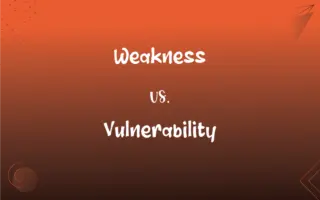Silicate vs. Silicon: What's the Difference?
Edited by Aimie Carlson || By Janet White || Updated on November 13, 2023
Silicate refers to a compound containing silicon bonded to oxygen. Silicon is a chemical element used in electronics and various alloys.
Key Differences
Silicates are compounds made of silicon, oxygen, and other elements, forming a complex structure. They are the most common materials in the Earth's crust. Silicon, on the other hand, is a pure element with the symbol Si, used primarily in semiconductor technology and as a component in alloys and ceramics.
Silicates are found abundantly in nature as part of minerals and rocks, like quartz and feldspar. They have a wide range of applications in ceramics, glass, and construction materials. Silicon is extracted from quartz and is essential in the manufacture of computer chips, solar panels, and electronic devices.
Silicates typically exhibit a crystalline structure and are known for their hardness and stability. They vary in form and function, including both gemstones and common minerals. Silicon is a metalloid, known for its semi-conducting properties, and is crucial in the electronics industry for its ability to conduct electricity under certain conditions.
The industrial use of silicates spans from glass making to being additives in cement. They are integral to traditional industries like construction. Silicon, in contrast, is a key player in modern technology, particularly in computing and renewable energy sectors.
Silicates, being natural minerals, are an integral part of the Earth's ecosystem and are used sustainably in various industries. Silicon, while also derived from natural sources, has a significant impact on the environment, particularly in its role in technology and its extraction and processing methods.
ADVERTISEMENT
Comparison Chart
Chemical Nature
Compound containing silicon and oxygen.
Pure chemical element with atomic number 14.
Typical Uses
In glass, ceramics, and construction materials.
In semiconductors, electronics, and solar panels.
Occurrence
Naturally in various minerals and rocks.
Extracted from silica, occurring in quartz and sand.
Properties
Crystalline structure, varying hardness.
Semi-conducting, used in electronic applications.
Environmental Impact
Common and generally sustainable.
Significant, especially in extraction and tech use.
ADVERTISEMENT
Silicate and Silicon Definitions
Silicate
A substance used in construction materials.
Silicate minerals are a key component in cement.
Silicon
A chemical element used in semiconductors and electronics.
Silicon chips are at the heart of modern computers.
Silicate
A mineral compound containing silicon and oxygen.
Quartz is a common type of silicate mineral.
Silicon
Extracted primarily from quartz for technological applications.
Silicon is refined from silica sand for industrial use.
Silicate
An ingredient in various types of glass and ceramics.
Silicate is used to enhance the durability of ceramic products.
Silicon
A key material in the manufacturing of solar cells.
The efficiency of solar cells depends on the purity of silicon used.
Silicate
A constituent of many rocks and natural substances.
Granite is composed of several different silicates.
Silicon
An element used in alloys and various chemical compounds.
Silicon is often added to aluminum to create a stronger alloy.
Silicate
A group of minerals forming the majority of Earth's crust.
Feldspar, another widespread silicate, is found in many igneous rocks.
Silicon
A metalloid with semi-conducting properties.
Silicon's ability to conduct electricity makes it ideal for solar panels.
Silicate
Any of numerous compounds containing silicon, oxygen, and one or more metals; a salt of silicic acid.
Silicon
A nonmetallic element occurring extensively in the earth's crust in silica and silicates, having both a brown amorphous and a gray lustrous crystalline allotrope, and used doped or in combination with other materials in glass, semiconducting devices, concrete, brick, refractories, pottery, and silicones. Atomic number 14; atomic weight 28.086; melting point 1,414°C; boiling point 3,265°C; specific gravity 2.33 (25°C); valence 2, 4. See Periodic Table.
Silicate
Any of a large group of minerals, forming over 90 percent of the earth's crust, that consist of SiO2 or SiO4 groupings combined with one or more metals and sometimes hydrogen.
Silicon
A nonmetallic element (symbol Si) with an atomic number of 14 and atomic weight of 28.0855.
Silicate
(inorganic chemistry) Any salt of silica or of one of the silicic acids; any mineral composed of silicates
Silicon
A single atom of this element.
Silicate
A salt of silicic acid.
Silicon
(slang) computing
Silicate
A salt or ester derived from silicic acid
Silicon
(slang) computer processor
Silicon
Abbreviation of silicon chip
Silicon
A nonmetalic element analogous to carbon. It always occurs combined in nature, and is artificially obtained in the free state, usually as a dark brown amorphous powder, or as a dark crystalline substance with a meetallic luster. Its oxide is silica, or common quartz, and in this form, or as silicates, it is, next to oxygen, the most abundant element of the earth's crust. Silicon is characteristically the element of the mineral kingdom, as carbon is of the organic world. Symbol Si. Atomic weight 28. Called also silicium.
Silicon
A tetravalent nonmetallic element; next to oxygen it is the most abundant element in the earth's crust; occurs in clay and feldspar and granite and quartz and sand; used as a semiconductor in transistors
FAQs
Can silicates be used in electronics?
Not typically; they're more common in construction and ceramics.
Is silicon found in its pure form in nature?
Rarely; it's usually found combined with oxygen in silica.
Is silicon the same as silicone?
No, silicon is a chemical element, while silicone is a polymer containing silicon.
Can silicon be recycled?
Yes, especially from electronic waste.
Are silicates renewable?
They are abundant and not considered a depletable resource.
Are silicates important for the environment?
Yes, they are a major component of the Earth's crust.
Are all rocks made of silicates?
Many are, but not all rocks contain silicates.
How is silicon extracted for industrial use?
Mostly from quartz through a reduction process.
Do silicates have any biological importance?
Yes, some organisms use silicates, like diatoms in their shells.
Are silicates soluble in water?
Generally, no; they are known for their stability.
Is silicon used in jewelry?
Not typically; silicates like quartz are used instead.
Is silicon used in medical applications?
Not directly; silicone, derived from silicon, is used.
Is silicon a rare element?
No, it's the second most abundant element in the Earth's crust.
Is silicon a conductor of electricity?
It's a semiconductor, conducting under certain conditions.
Can silicon be used in glass making?
Yes, as a component in the form of silica.
Does silicon have any health effects?
In its pure form, it's generally inert, but fine particles can be hazardous.
Do silicates contribute to soil fertility?
They can, by providing minerals essential for plant growth.
Is silicon used in batteries?
Yes, it's being explored for use in advanced battery technologies.
How are silicates formed?
Through geological processes, often involving volcanic activity.
Can silicates be synthetic?
Yes, synthetic silicates are made for various industrial uses.
About Author
Written by
Janet WhiteJanet White has been an esteemed writer and blogger for Difference Wiki. Holding a Master's degree in Science and Medical Journalism from the prestigious Boston University, she has consistently demonstrated her expertise and passion for her field. When she's not immersed in her work, Janet relishes her time exercising, delving into a good book, and cherishing moments with friends and family.
Edited by
Aimie CarlsonAimie Carlson, holding a master's degree in English literature, is a fervent English language enthusiast. She lends her writing talents to Difference Wiki, a prominent website that specializes in comparisons, offering readers insightful analyses that both captivate and inform.































































